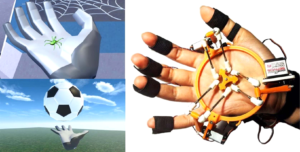
Many products are designed to communicate with their users. Historically these have been audible and visual alerts, such as LEDs, beeps, bells, amongst others. Haptic feedback, and its simpler relative ‘vibration alerting’, are in increasing demand to augment or replace the old alert methods.
Haptics uses a vibrating component (sometimes called actuator) such as a vibration motor or a linear resonant actuator which is driven by an electronic circuit. It is common for a microcontroller to decided when to vibrate and with which pattern, and for a dedicated haptic driver chip to control the actuator. Of course, there is a range of varieties on the engineering side, you can read about them in the Essentials for Haptics section of the Adding and Improving Haptics page. But first, we continue with our introduction to haptic technology.
What is haptic feedback?
Any gamer – or anyone with a mobile phone for that matter – is well versed in the art of vibration feedback. Whether you’re getting a text or phone call, experiencing the rumble of the machine gun firing in an FPS, or colliding with another vehicle in a racing game, that sense of vibration and its intensity is very familiar nowadays. But the problem with traditional rumble packs is that the vibration is all on one level, with little variation in its intensity regardless of its cause.
That’s where haptic feedback comes in. Haptic feedback is all about better simulating what it would feel like to touch or interact with something in real life, allowing precision vibrations that help better represent what’s happening in-game. Rather than the blasting vibrations of current controllers, haptic feedback allows there to be a lot more subtlety, ranging from the delicate splashing of raindrops to something more severe like an explosion.
While we may not immediately see the fruits of some of the visual enhancements coming with PS5 and Xbox Series X – like 8K for example – the benefits of haptic technology will be immediate. It’s aimed at heightening your immersion, allowing you to feel more physically connected to what you’re doing as you play.
Razer’s Jeevan Aurol, who has worked with the company’s Hypersense haptics technology, explains that the benefits of haptics are easily palpable to a player, especially as it’s “a lot more straightforward than visuals or sound. Visual and sound technology can be very subjective, depending on how in-tune you are with the subtle differences. But when it comes to haptics, you feel it.”
“Feeling gunshots coming at you from the left or right; feeling explosions coming at you from those directions – it’s something that can add to the experience very easily without a lot of education, at least from a consumer perspective.
You’ve probably already experienced haptic feedback
Despite the fact it might feel like a buzzword right now, haptic feedback isn’t actually a new technology, and no doubt you may well have heard about it, or experienced it elsewhere. Ever since Apple introduced its own Taptics technology back in 2015, we’ve been able to experience tactile sensations for games, notifications, and more through iPhones, and Apple Watches.
But the technology already extends into gaming consoles too. The Nintendo Switch, for example, already uses haptic feedback in its pair of Joy-Con controllers. If you haven’t already, go and try 1-2 Switch, a collection of mini-games that is not only fun but does an incredible job of showing off the nuance of haptic feedback’s vibration capabilities – particularly in the safe-cracking game where you can feel the notches on the dial as you turn it, and the ball count game that asks you to guess how many metal balls you can feel rolling around inside your controller.
Nintendo never actually calls the technology haptic feedback, it instead uses its terminology called Rumble HD. “The Joy-Con can convey to you the feeling of ice cubes colliding in a cup,” explained Yoshiaki Koizumi, a general development producer at Nintendo, during the Switch’s full reveal in January 2017. “You can even tell the number of ice cubes in the glass. And you can feel the water filling the glass. This new sense of realism is produced by the precision of the new HD Rumble.”
However, it’s not just Nintendo that has already been experimenting with haptic feedback. Microsoft introduced the technology into its controllers with the original launch of the Xbox One. The Xbox One controller arrived with what Microsoft calls impulse triggers, which included adding four vibration motors to the pad. There’s one behind each trigger, and one in each grip, which when combined creates a better sense of in-game directionality and depth, especially when it comes to gunshots, car crashes, and explosions.
How Can I Experience Haptic Feedback?
Experiencing basic haptic feedback is fairly easy. As we mentioned above, it is present in a variety of real-world applications and products. Most will easily understand simple haptics from using their smartphone, although this is just scratching the surface.
If you’re interested in experimenting with advanced haptic feedback, but don’t want to build the detailed circuitry, then our Haptic Feedback Evaluation Kit is the perfect solution. A list of all of its features can be found here, and you can order it online through our product catalog.
By simulating both a handheld product and a mounted capacitive touch surface in one kit, you can evaluate haptic feedback and easily share your findings with colleagues and managers. It is an easy first step to improving your product with haptics.
